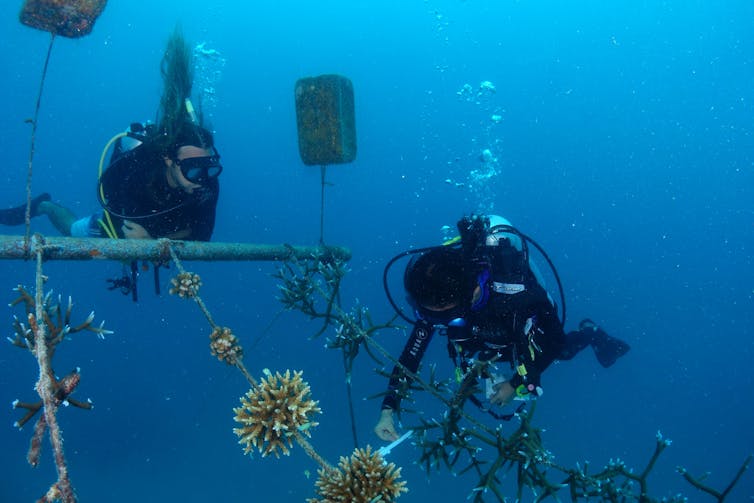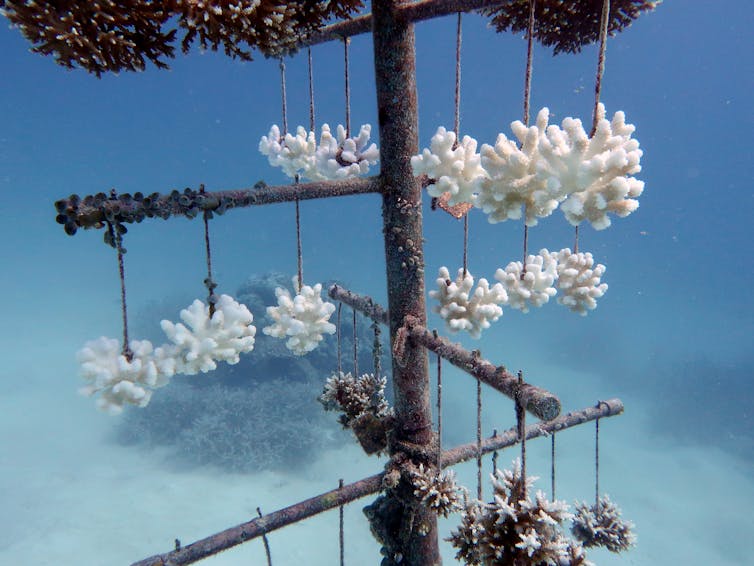 |
| Shutterstock |
Monday, 14 April 2025
Easter 2025
Saturday, 12 April 2025
Climate change and the loss of coral reefs
Reality check: coral restoration won’t save the world’s reefs
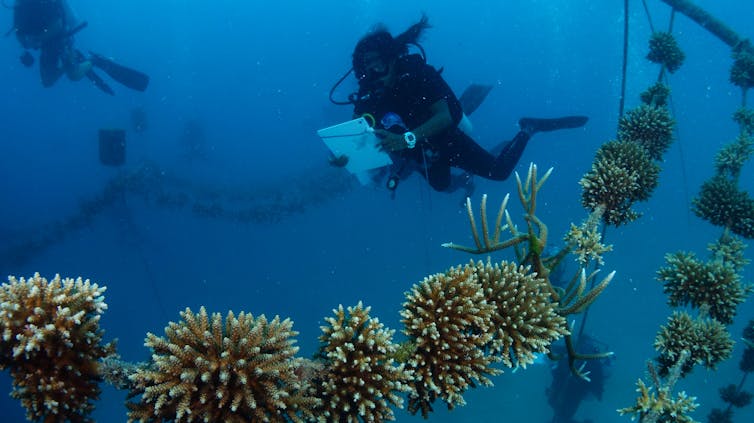
Coral reefs are much more than just a pretty place to visit. They are among the world’s richest ecosystems, hosting about a third of all marine species.
These reefs also directly benefit more than a billion people, providing livelihoods and food security, as well as protection from storms and coastal erosion.
Without coral reefs, the world would be a much poorer place. So when corals die or become damaged, many people try to restore them. But the enormity of the task is growing as the climate keeps warming.
In our new research, we examined the full extent of existing coral restoration projects worldwide. We looked at what drives their success or failure, and how much it would actually cost to restore what’s already been lost. Restoring the reefs we’ve already lost around the world could cost up to A$26 trillion.
Global losses
Sadly, coral reefs are suffering all over the world. Global warming and marine heatwaves are the main culprits. But overfishing and pollution make matters worse.
When sea temperatures climb above the seasonal average for sustained periods, corals can become bleached. They lose colour as they expel their symbiotic algae when stressed, revealing the white skeleton underneath. Severe bleaching can kill coral.
Coral bleaching and mass coral deaths are now commonplace. Last month, a massive warm-water plume bleached large areas of Ningaloo Reef on Australia’s northwest coast just as large sections of the northern Great Barrier Reef were bleaching on the northeast coast.
Since early 2023, mass coral bleaching has occurred in throughout the tropics and parts of the Indian Ocean.
Over the past 40 years, the extent of coral reefs has halved. As climate change continues, bleaching events and coral deaths will become more common. More than 90% of coral reefs are at risk of long-term degradation by the end of the century.
Direct intervention
Coral reef restoration can take many forms, including removing coral-eating species such as parrot fish, transferring coral spawn, or even manipulating the local community of microbes to improve coral survival.
But by far the most common type of restoration is “coral gardening”, where coral fragments grown in nurseries are transplanted back to the reef.
The problem is scale. Coral restoration can only be done successfully at a small scale. Most projects only operate over several hundred or a few thousand square metres. Compare that with nearly 12,000 square km of loss and degradation between 2009 and 2018. Restoration projects come nowhere near the scale needed to offset losses from climate change and other threats.
Sky-high costs
Coral restoration is expensive, ranging from around $10,000 to $226 million per hectare. The wide range reflects the variable costs of different techniques used, ease of access, and cost of labour. For example, coral gardening (coral fragments grown in nurseries transplanted back to the reef) is relatively cheap (median cost $558,000 per hectare) compared with seeding coral larvae (median $830,000 per hectare). Building artificial reefs can cost up to $226 million per hectare.
We estimated it would cost more than $1.6 billion to restore just 10% of degraded coral areas globally. This is using the lowest cost per hectare and assuming all restoration projects are successful.
Even our conservative estimate is four times more than the total investment in coral restoration over the past decade ($410 million).
But it’s reasonable to use the highest cost per hectare, given high failure rates, the need to use several techniques at the same site, and the great expense of working on remote reefs. Restoring 10% of degraded coral areas globally, at $226 million a hectare, would cost more than $26 trillion – almost ten times Australia’s annual GDP.
It is therefore financially impossible to tackle the ongoing loss of coral reefs with restoration, even if local projects can still provide some benefits.
Location, location, location
Our research also looked at what drives the choice of restoration sites. We found it depends mostly on how close a reef is to human settlements.
By itself, this isn’t necessarily a bad thing. But we also found restoration actions were more likely to occur in reefs already degraded by human activity and with fewer coral species.
This means we’re not necessarily targeting sites where restoration is most likely to succeed, or of greatest ecological importance.
Another limitation is coral gardening normally involves only a few coral species – the easiest to rear and transplant. While this can still increase coral cover, it does not restore coral diversity to the extent necessary for healthy, resilient ecosystems.
Measuring ‘success’
Another sad reality is that more than a third of all coral restoration efforts fail. The reasons why can include poor planning, unproven technologies, insufficient monitoring, and subsequent heatwaves.
Unfortunately, there’s no standard way to collect data or report on restoration projects. This makes it difficult – or impossible – to identify conditions leading to success, and reduces the pace of improvement.
Succeed now, fail later
Most coral transplants are monitored for less than 18 months. Even if they survive that period, there’s no guarantee they will last longer. The long-term success rate is unknown.
When we examined the likelihood of extreme heat events immediately following restoration and in coming decades, we found most restored sites had already experienced severe bleaching shortly after restoration. It will be difficult to find locations that will be spared from future global warming.
No substitute for climate action
Coral restoration has the potential to be a valuable tool in certain circumstances: when it promotes community engagement and addresses local needs. But it is not yet – and might never be – feasible to scale up sufficiently to have meaningful long-term positive effects on coral reef ecosystems.
This reality check should stimulate constructive debate about when and where restoration is worthwhile. Without stemming the pace and magnitude of climate change, we have little power to save coral reefs from massive losses over the coming century and beyond.
Other conservation approaches such as establishing, maintaining and enforcing marine protected areas, and improving water quality, could improve the chance a coral restoration project will work. These efforts could also support local human communities with incentives for conservation.
Reinforcing complementary strategies could therefore bolster ecosystem resilience, extending the reach and success of coral restoration projects.![]()
Corey J. A. Bradshaw, Matthew Flinders Professor of Global Ecology and Node Leader in the ARC Centre of Excellence for Indigenous and Environmental Histories and Futures, Flinders University; Clelia Mulà, PhD student in Marine Ecology, The University of Western Australia, and Giovanni Strona, Doctoral program supervisor, University of Helsinki
This article is republished from The Conversation under a Creative Commons license. Read the original article.
Saturday, 5 April 2025
Fake images - real or not ?
Can you tell the difference between real and fake news photos? Take the quiz to find out

You wouldn’t usually associate Pikachu with protest.
But a figure dressed as the iconic yellow Pokémon joined a protest last week in Turkey to demonstrate against the country’s authoritarian leader.
And then a virtual doppelgänger made the rounds on social media, raising doubt in people’s minds about whether what they were seeing was true. (Just to be clear, the image in the post shown below is very much fake.)
This is the latest in a spate of incidents involving AI-generated (or AI-edited) images that can be made easily and cheaply and that are often posted during breaking news events.
Doctored, decontextualised or synthetic media can cause confusion, sow doubt, and contribute to political polarisation. The people who make or share these media often benefit financially or politically from spreading false or misleading claims.
How would you go at telling fact from fiction in these cases? Have a go with this quiz and learn more about some of AI’s (potential) giveaways and how to stay safer online.
How’d you go?
As this exercise might have revealed, we can’t always spot AI-generated or AI-edited images with just our eyes. Doing so will also become harder as AI tools become more advanced.
Dealing with visual deception
AI-powered tools exist to try to detect AI content, but these have mixed results.
Running suspect images through a search engine to see where else they have been published – and when – can be a helpful strategy. But this relies on there being an original “unedited” version published somewhere online.
Perhaps the best strategy is something called “lateral reading”. It means getting off the page or platform and seeing what trusted sources say about a claim.
Ultimately, we don’t have time to fact-check every claim we come across each day. That’s why it’s important to have access to trustworthy news sources that have a track record of getting it right. This is even more important as the volume of AI “slop” increases.![]()
T.J. Thomson, Senior Lecturer in Visual Communication & Digital Media, RMIT University
This article is republished from The Conversation under a Creative Commons license. Read the original article.
Tuesday, 1 April 2025
Goodbye to the Gaia telescope
The best space telescope you never heard of just shut down
On Thursday 27 March, the European Space Agency (ESA) sent its last messages to the Gaia Spacecraft. They told Gaia to shut down its communication systems and central computer and said goodbye to this amazing space telescope.
Gaia has been the most successful ESA space mission ever, so why did they turn Gaia off? What did Gaia achieve? And perhaps most importantly, why was it my favourite space telescope?
Running on empty
Gaia was retired for a simple reason: after more than 11 years in space, it ran out of the cold gas propellant it needed to keep scanning the sky.
The telescope did its last observation on 15 January 2025. The ESA team then performed testing for a few weeks, before telling Gaia to leave its home at a point in space called L2 and start orbiting the Sun away from Earth.
L2 is one of five “Lagrangian points” around Earth and the Sun where gravitational conditions make for a nice, stable orbit. L2 is located 1.5 million kilometres from Earth on the “dark side”, opposite the Sun.
L2 is a highly prized location because it’s a stable spot to orbit, it’s close enough to Earth for easy communication, and spacecraft can use the Sun behind them for solar power while looking away from the Sun out into space.
It’s also too far away from Earth to send anyone on a repair mission, so once your spacecraft gets there it’s on its own.
Keeping L2 clear
L2 currently hosts the James Webb Space Telescope (operated by the USA, Europe and Canada), the European Euclid mission, the Chinese Chang’e 6 orbiter and the joint Russian-German Spektr-RG observatory. Since L2 is such a key location for space missions, it’s essential to keep it clear of debris and retired spacecraft.
Gaia used its thrusters for the last time to push itself away from L2, and is now drifting around the Sun in a “retirement orbit” where it won’t get in anybody’s way.
As part of the retirement process, the Gaia team wrote farewell messages into the craft’s software and sent it the names of around 1,500 people who worked on Gaia over the years.
What is Gaia?
Gaia looks a bit like a spinning top hat in space. Its main mission was to produce a detailed, three-dimensional map of our galaxy, the Milky Way.
To do this, it measured the precise positions and motions of 1.46 billion objects in space. Gaia also measured brightnesses and variability and those data were used to provide temperatures, gravitational parameters, stellar types and more for millions of stars. One of the key pieces of information Gaia provided was the distance to millions of stars.
A cosmic measuring tape
I’m a radio astronomer, which means I use radio telescopes here on Earth to explore the Universe. Radio light is the longest wavelength of light, invisible to human eyes, and I use it to investigate magnetic stars.
But even though I’m a radio astronomer and Gaia was an optical telescope, looking at the same wavelengths of light our eyes can see, I use Gaia data almost every single day.
I used it today to find out how far away, how bright, and how fast a star was. Before Gaia, I would probably never have known how far away that star was.
This is essential for figuring out how bright the stars I study really are, which helps me understand the physics of what’s happening in and around them.
A huge success
Gaia has contributed to thousands of articles in astronomy journals. Papers released by the Gaia collaboration have been cited well over 20,000 times in total.
Gaia has produced too many science results to share here. To take just one example, Gaia improved our understanding of the structure of our own galaxy by showing that it has multiple spiral arms that are less sharply defined than we previously thought.
Not really the end for Gaia
It’s difficult to express how revolutionary Gaia has been for astronomy, but we can let the numbers speak for themselves. Around five astronomy journal articles are published every day that use Gaia data, making Gaia the most successful ESA mission ever. And that won’t come to a complete stop when Gaia retires.
The Gaia collaboration has published three data releases so far. This is where the collaboration performs the processing and checks on the data, adds some important analysis and releases all of that in one big hit.
And luckily, there are two more big data releases with even more information to come. The fourth data release is expected in mid to late 2026. The fifth and final data release, containing all of the Gaia data from the whole mission, will come out sometime in the 2030s.
This article is my own small tribute to a telescope that changed astronomy as we know it. So I will end by saying a huge thank you to everyone who has ever worked on this amazing space mission, whether it was engineering and operations, turning the data into the amazing resource it is, or any of the other many jobs that make a mission successful. And thank you to those who continue to work on the data as we speak.
Finally, thank you to my favourite space telescope. Goodbye, Gaia, I’ll miss you.![]()
Laura Nicole Driessen, Postdoctoral Researcher in Radio Astronomy, University of Sydney
This article is republished from The Conversation under a Creative Commons license. Read the original article.
Tuesday, 25 March 2025
How plants breath
Plants breathe with millions of tiny mouths. We used lasers to understand how this skill evolved
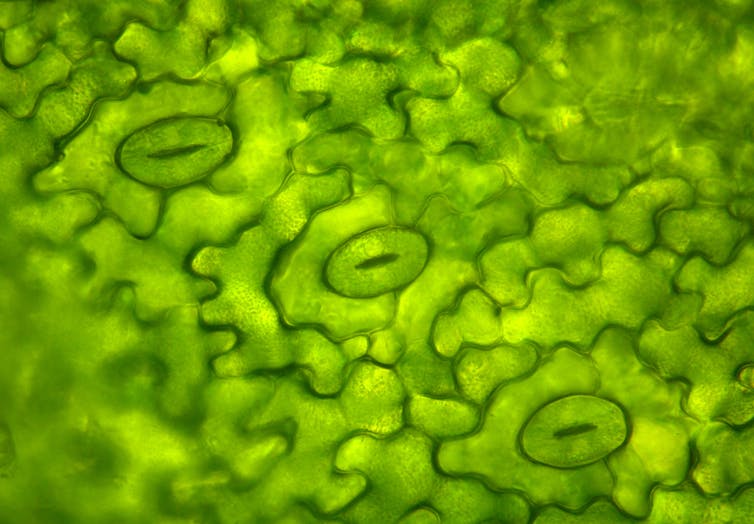
Plant behaviour may seem rather boring compared with the frenetic excesses of animals. Yet the lives of our vegetable friends, who tirelessly feed the entire biosphere (including us), are full of exciting action. It just requires a little more effort to appreciate.
One such behaviour is the dynamic opening and closing of millions of tiny mouths (called stomata) located on each leaf, through which plants “breathe”. In this process they let out water extracted from the soil in exchange for precious carbon dioxide from the air, which they need to produce sugar in the sunlight-powered process of photosynthesis.
Opening the stomata at the wrong time can waste valuable water and risk a catastrophic drying-out of the plant’s vascular system. Almost all land plants control their stomata very precisely in response to light and humidity to optimise growth while minimising the damage risk.
How plants evolved this extraordinary balancing act has been the subject of considerable debate among scientists. In a new paper published in PNAS we used lasers to find out how the earliest stomata may have operated.
Tiny valves, global consequences
Much depends on the way stomata behave: plant productivity, sensitivity to drought, and indeed the pace of the global carbon and water cycles.
However, they are difficult to observe in action. Each stomata is like a tiny, pressure-operated valve. They have “guard cells” surrounding an opening or pore which lets water vapour out and carbon dioxide in.

When fluid pressure increases inside the stomata’s guard cells, they swell up to open the pore. When pressure drops, the cells deflate and the pore closes. To understand stomata behaviour, we wanted to be able to measure the pressure in the guard cells – but it’s not easy.
Lasers, bubbles and evolution
Enter Craig Brodersen of Yale University with a newly developed microscope-guided laser. It can create microscopic bubbles inside the individual cells that operate the stomatal pore.
When Brodersen spent a sabbatical at the University of Tasmania (where I am based), we found we could determine the pressure inside stomatal cells by tracking the size of these bubbles and how quickly they collapsed. This involved theoretical calculations guided by bubble expert Philippe Marmottant, of the French National Centre for Scientific Research (CNRS) in Grenoble.
This new tool gave us the perfect opportunity to explore how the behaviour of stomata is different among major plant groups. The aim was to test our hypothesis that the evolution of stomatal behaviour follows a predictable trajectory through the history of plant evolution.
We argue it began with a relatively simple ancestral passive control state, currently represented in living ferns and lycophytes, and developed to a more active hormonal control mechanism seen in modern conifers and flowering plants.
Against this hypothesis, some researchers have previously reported complex behaviours in some of the most ancient of stomata-bearing plants, the bryophytes. We wanted to test this finding using our newly developed laser instrument.
400 million years of development
What we found was firstly that our laser pressure probe technique worked extremely well. We made nearly 500 measurements of stomatal pressure dynamics in the space of a few months. This was a marked improvement on the past 45 years, in which fewer than 30 similar measurements had been made.
Secondly, we found that the stomata of our representative bryophytes (hornworts and mosses) lacked even the most basic responses to light found in all other land plants.
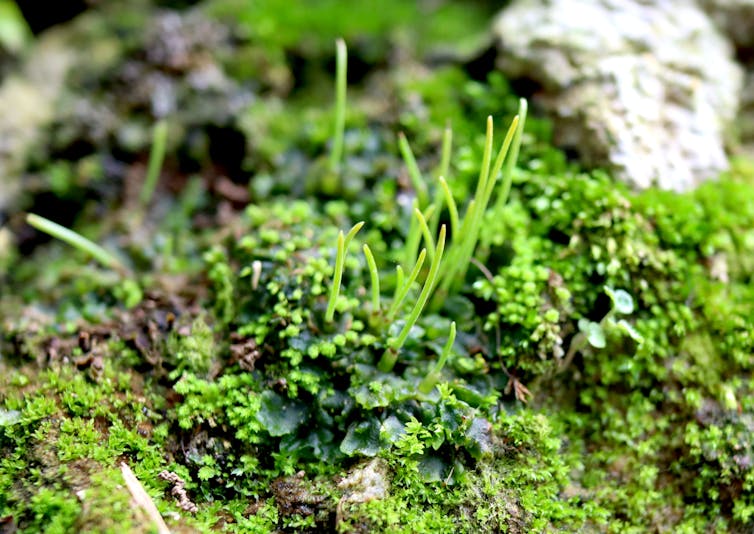
This result supported our earlier hypothesis that the first stomata found in ancestors of the modern bryophytes 450 million years ago should have been very simple valves. They would have lacked the complex behaviours seen in modern flowering plants.
Our results suggest that stomatal behaviour has changed substantially through the process of evolution, highlighting critical changes in functionality that are preserved in the different major land plant groups that currently inhabit the Earth.
How plants will survive the future
We can now say with confidence that stomata in mosses, ferns, conifers and flowering plants all behave in very different ways. This has an important corollary: they will all respond differently to the heaving changes in atmospheric temperature and water availability that they face now and into the near future. Predicting stomatal behaviour in the future will help us to predict these impacts and highlight plant vulnerability.
In terms of agricultural benefit, our new laser method should be fast and sensitive enough to reveal even small differences in the the behaviour of closely related plants. This may help to identify crop variants that use water in a more efficient or productive way, which will assist plant breeders to find varieties that better translate increasingly unpredictable soil water supplies into food.
So next time you look upon a leaf, consider the frantic pace of dynamic calculation and adjustment of millions of little mouths, reacting as your breath falls upon them. Realise that our own fate, tied to the performance of forests and crops in future climates, hangs on the behaviour of the stomata of different species. A good reason for us to understand these unassuming little valves.![]()
Tim Brodribb, Professor of Plant Physiology, University of Tasmania
This article is republished from The Conversation under a Creative Commons license. Read the original article.
Saturday, 22 March 2025
Scientific misconduct
Scientific misconduct is on the rise. But what exactly is it?

German anaesthesiologist Joachim Boldt has an unfortunate claim to fame. According to Retraction Watch, a public database of research retractions, he is the most retracted scientist of all time. To date, 220 of his roughly 400 published research papers have been retracted by academic journals.
Boldt may be a world leader, but he has plenty of competition. In 2023, more than 10,000 research papers were retracted globally – more than any previous year on record. According to a recent investigation by Nature, a disproportionate number of retracted papers over the past ten years have been written by authors affiliated with several hospitals, universities and research institutes in Asia.
Academic journals retract papers when they are concerned that the published data is faked, altered, or not “reproducible” (meaning it would yield the same results if analysed again).
Some errors are honest mistakes. However, the majority of retractions are associated with scientific misconduct.
But what exactly is scientific misconduct? And what can be done about it?
From fabrication to plagiarism
The National Health and Medical Research Council is Australia’s primary government agency for medical funding. It defines misconduct as breaches of the Code for the Responsible Conduct of Research.
In Australia, there are broadly eight recognised types of breaches. Research misconduct is the most severe.
These breaches may include failure to obtain ethics approval, plagiarism, data fabrication, falsification and misrepresentation.
This is what was behind many of Boldt’s retractions. He made up data for a large number of studies, which ultimately led to his dismissal from the Klinikum Ludwigshafen, a teaching hospital in Germany, in 2010.
In another case, China’s He Jiankui was sentenced to three years in prison in 2019 for creating the world’s first genetically edited babies using the gene-editing technology known as CRISPR. His crime was that he falsified documents to recruit couples for his research.
The “publish or perish” culture within academia fuels scientific misconduct. It puts pressure on academics to meet publication quotas. It also rewards them for greater research output, in the form of promotions, funding and recognition. And this can mean research quality is sacrificed for quantity.
Honest mistakes
But not all research misconduct is premeditated. Some is the result of honest mistakes made by scientists.
For example, Sergio Gonzalez, a young scientist at the Institute for Neurosciences of Montpellier in France, mistakenly uploaded several wrong images to an academic paper and its supplementary material. This didn’t have any effect on the findings of the paper, which were based on the correct images.
But it still represented a case of image duplication and misrepresentation of data. This lead to the journal retracting the paper and launching an investigation. The investigation concluded the breach was unintentional and resulted from the pressures of academic research.
Fewer than 20% of all retractions are due to honest mistakes. Researchers usually contact the publisher to correct errors when they are detected, with no major consequences.
The need for a national oversight body
In many countries, an independent national body oversees research integrity.
In the United Kingdom, this body is known as the Committee on Research Integrity. It is responsible for improving research integrity and addressing misconduct cases. Similarly, in the United States, the Office of Research Integrity handles allegations of research misconduct.
In contrast, Australia lacks an independent body directly tasked with investigating research misconduct. There is a body known as the Australian Research Integrity Committee. But it only reviews the institutional procedures and governance of investigations to ensure they are conducted fairly and transparently – and with limited effectiveness. For example, last year it received 13 complaints, only five of which were investigated.
Instead Australia relies on a self-regulation model. This means each university and research institute aligns its own policy with the Code for the Responsible Conduct of Research. Although this code originated in medical research, its principles apply across all disciplines.
For example, in archaeology, falsifying an image or deliberately reporting inaccurate carbon dating results constitutes data fabrication. Another common breach is plagiarism, which can also be applied to all fields.
But self-governance on integrity matters is fraught with problems.
Investigations often lack transparency and are carried out internally, creating a conflict of interest. Often the investigative teams are under immense pressure to safeguard their institution’s reputation rather than uphold accountability.
A 2023 report by the Australia Institute called for the urgent establishment of an independent, government-funded research integrity watchdog.
The report recommended the watchdog have direct investigatory powers and that academic institutions be bound by its findings.
The report also recommended the watchdog should release its findings publicly, create whistleblower protections, establish a proper appeals process and allow people to directly raise complaints with it.
Research credibility is on the line
The consequences of inadequate oversight are already evident.
One of the biggest research integrity scandals in Australian history involved Ali Nazari, an engineer from Swinburne University. In 2022 an anonymous whistleblower alleged Nazari was part of an international research fraud cartel involving multiple teams.
Investigations cast doubt on the validity of the 287 papers Nazari and the other researchers had collectively published. The investigations uncovered numerous violations, including 71 instances of falsified results, plagiarism and duplication, and 208 instances of self-plagiarism.
Similarly, Mark Smyth, formerly of the Queensland Institute of Medical Research, fabricated research data to support grant applications and clinical trials. An independent inquiry concluded he used his reputation, status and authority to bully and intimidate junior colleagues.
If Australia had a independent research integrity body, there would be a clear governance structure and an established and transparent pathway for reporting breaches at a much earlier stage.
Timely intervention would help reduce further breaches through swift investigation and corrective action. Importantly, consistent governance across Australian institutions would help ensure fairness. It would also reduce bias and uphold the same standards across all misconduct cases.
The call for an independent research integrity watchdog is long overdue.
Only through impartial oversight can we uphold the values of scientific excellence, protect public trust, and foster a culture of accountability that strengthens the integrity of research for all Australians.![]()
Nham Tran, Associate Professor, School of Biomedical Engineering, University of Technology Sydney
This article is republished from The Conversation under a Creative Commons license. Read the original article.



